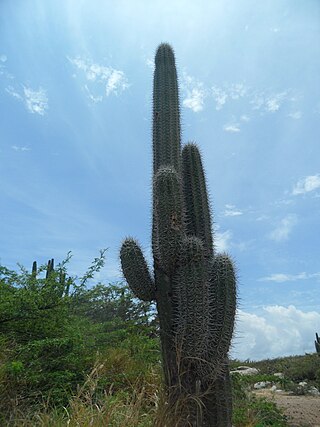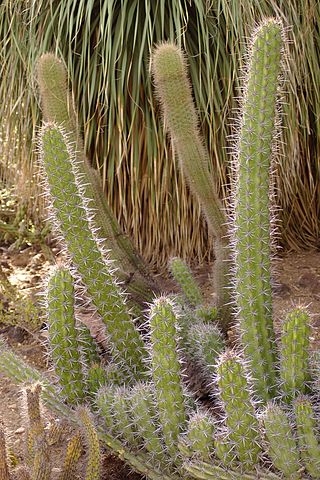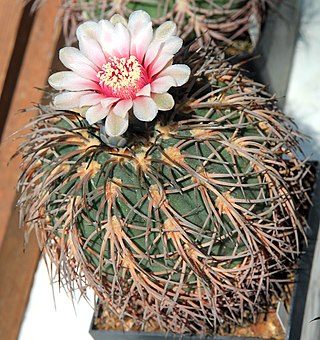
Isolatocereus is a monotypic genus of flowering plant in the family Cactaceae. The only species is Isolatocereus dumortieri that is found in Mexico.

Cereus repandus, the Peruvian apple cactus, is a large, erect, spiny columnar cactus found in South America. It is also known as giant club cactus, hedge cactus, cadushi, and kayush.

Stenocereus griseus, also known as the Mexican organ pipe, dagger cactus, pitaya, and pitayo de mayo, is a species of cactus.

Ferocactus robustus is a barrel cactus in the genus Ferocactus of the family Cactaceae.

Thelocactus rinconensis, synonyms including Thelocactus nidulans, is a species of cactus. It is endemic to north-east Mexico.

Stenocereus gummosus is a flowering plant in the family Cactaceae that is found in Baja California, Mexico at elevations of 9 to 134 meters

Stenocereus stellatus is a flowering plant in the family Cactaceae that is found in Oaxaca, Mexico

Gymnocalycium monvillei is a species of Gymnocalycium from Argentina.

Gymnocalycium spegazzinii is a species of Gymnocalycium from Argentina and Bolivia named after the botanist C. L. Spegazzini.

Lobivia ferox, is a species of Lobivia found in Bolivia and Argentina.

Stenocereus heptagonus is a species of cactus.
Stenocereus martinezii is a species of flowering plant in the family Cactaceae, native to Sinaloa in Mexico. A candelabriform cactus typically 5 to 7 m tall, it is easy to propagate from cuttings, so local people use it to build live fences.

Stenocereus treleasei, commonly known as tunillo, is a species of flowering plant in the family Cactaceae, native to Oaxaca in Mexico.

Cochemiea poselgeri is a species of Cochemiea found in Mexico

Cochemiea albicans is a species of Cochemiea found in Mexico.

Echinocereus barthelowianus is a species of cactus native to Mexico.
Stenocereus fricii is a species of cactus in the genus Stenocereus, endemic to Mexico.
Stenocereus chacalapensis is a species of cactus in the genus Stenocereus, endemic to Mexico.
Stenocereus chrysocarpus is a species of cactus in the genus Stenocereus, endemic to Mexico.
Stenocereus humilis is a species of cactus in the genus Stenocereus, endemic to Mexico.


















